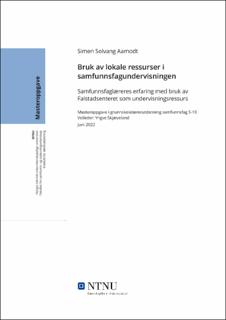| dc.contributor.advisor | Skjæveland, Yngve | |
| dc.contributor.author | Aamodt, Simen Solvang | |
| dc.date.accessioned | 2022-07-14T17:21:37Z | |
| dc.date.available | 2022-07-14T17:21:37Z | |
| dc.date.issued | 2022 | |
| dc.identifier | no.ntnu:inspera:110859567:33519870 | |
| dc.identifier.uri | https://hdl.handle.net/11250/3005620 | |
| dc.description.abstract | Læreplanen i samfunnsfag tilrettelegger for at elevene skal lære om seg selv, nærmiljøet de tilhører, og nasjonale og globale problemstillinger. For å konkretisere dette kan samfunnsfaglærere ta i bruk lokalsamfunnet som undervisningsressurs. Ut fra dette har problemstillingen i denne oppgaven vært Hvordan brukes Falstadsenteret som undervisningsressurs i undervisning for skoler i nærområdet til senteret? Avgresning og spesifisering av problemstillingen har jeg gjort ved å jobbe ut fra forskningsspørsmålene: Hvordan opplever lærerne at besøket på Falstadsenteret bidrar til å utvikle elevenes historiske empati? Hvordan opplever lærerne Falstadsenteret som en lokalhistorisk ressurs? Hvilke sammenhenger ser lærerne mellom besøk på Falstadsenteret og motivasjon for å lære samfunnsfag? Undersøkelsen er gjennomført ved å benytte kvalitativ metode. Innenfor denne metoden har det blitt gjort kvalitative intervjuer med fem samfunnsfaglærere på fem forskjellige ungdomsskoler i Innherredsregionen.
Lærerne bruker Falstadsenteret som undervisningsressurs ved at ungdomsskoleelever i nærområdet til senteret får komme dit for å gjennomgå et undervisningsopplegg. De mener at besøket på Falstadsenteret, med tilknyttet for- og etterarbeid, fører til at elevene får et godt læringsutbytte. Dette læringsutbyttet består ifølge lærerne av at elevene lærer om: andre verdenskrig og enkeltpersoner som opplevde krigen, fagstoffet i samfunnsfag satt i et nytt lys, nytteverdien av det de tidligere har lært i samfunnsfag, mer kunnskap innen historie og sammenhenger mellom fortiden og nåtiden. Lærerne mener at et besøk på Falstadsenteret er med på å utvikle elevenes historiske empati. Denne utviklingen skjer ved at elevene kommer nærmere historiske kilder. Elevenes utvikling av historisk empati kan forbedres ved at lærerne legger mer vekt på kontekstualisering og innlevelse. Falstadsenterets nærhet, konkretisering av de store linjene og forenkling av læringsprosessen gjør at lærerne ser på senteret som en lokalhistorisk ressurs. Falstadsenteret er også en lokalhistorisk ressurs i form av at elevene kan praktisere grunnleggende måter å tenke og arbeide innen faget historie på der, selv om lærerne ikke er særlig bevisste på dette. Falstadsenteret skaper motivasjon for å lære samfunnsfag fordi opplegget der fører til aktive og praktiske læringsmetoder og konkretisering. Besøk på Falstadsenteret er også motiverende for historieinteresserte ungdommer. | |
| dc.description.abstract | The social studies curriculum facilitates for students to learn about different aspects about their individual selves, such as the local environment they belong to, and the national and global issues. To specify this, social studies teachers can use the local community as a teaching resource. Based on this, the thesis questions How is the Falstad Center used as a teaching resource in teaching for schools in the vicinity of the center? In order to specify and delimit the thesis, I have worked on the basis of the research questions: How do the teachers experience that the visit to the Falstad Center contributes to developing the students' historical empathy? How do teachers experience the Falstad Center as a local historical resource? What connections do teachers see between visits to the Falstad Center and motivation to learn social studies? The survey was conducted using a qualitative method. Within this method, qualitative interviews have been conducted with five social studies teachers at five different secondary schools in the region of Innherred.
The teachers use the Falstad Center as a teaching resource in a way that secondary school students in the local area of the center can visit and be part of a teaching program. They believe that the visit to the Falstad Center, with associated pre- and post-work, leads to the pupils receiving a good learning outcome. According to the teachers, the learning outcome consists of the students learning about: World War II and individuals who experienced the war, the subject matter in social studies from another perspective, the usefulness of what they have previously learned in subjects, more knowledge in history and connections between past and present. The teachers are of the opinion that a visit to the Falstad Center helps to develop the students' historical empathy. This development takes place as the students get closer to historical sources. Students' development of historical empathy can be improved by teachers placing more emphasis on contextualization and empathy. The proximity of the Falstad Center, the concretization of the main context and the simplification of the learning process results in the teachers seeing the center as a local historical resource. The Falstad Centre is also a local historical resource in the form that students can practice basic methods of thinking and working with history, even if the teachers are not particularly aware of this. Based on these aspects, the Falstad Centre creates motivation to learn social studies because the program there leads to active and practical learning methods and concretization. Visiting the Falstad Centre is also motivating for adolescents who are interested in history. | |
| dc.language | nob | |
| dc.publisher | NTNU | |
| dc.title | Bruk av lokale ressurser i samfunnsfagundervisninga | |
| dc.type | Master thesis | |
